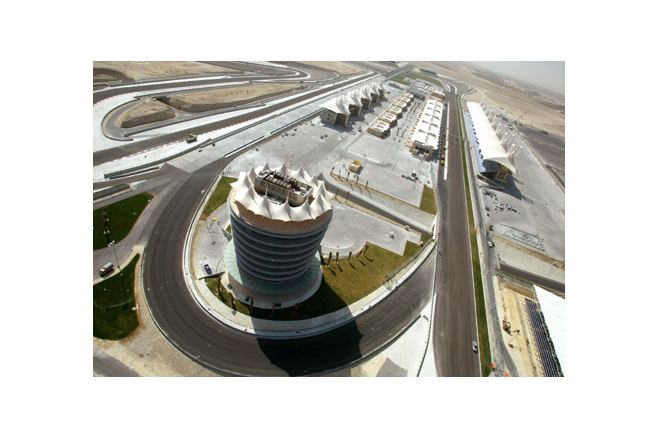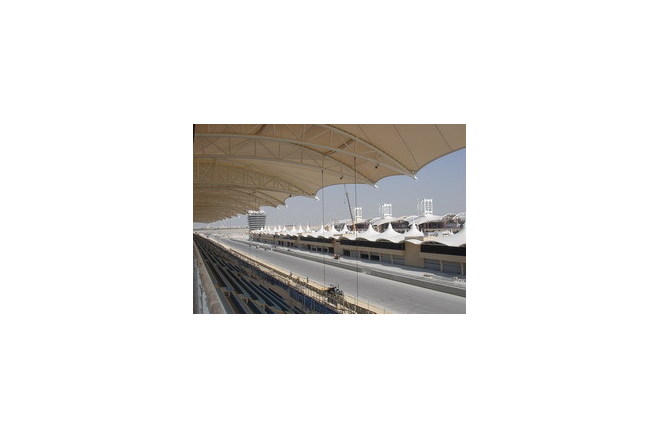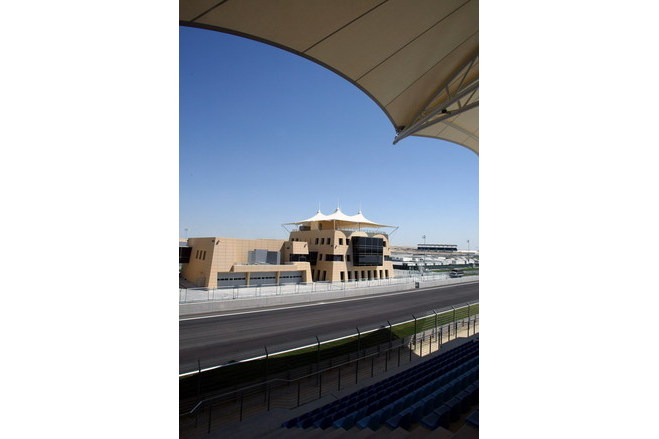Formula One Racing Circuit Bahrein
General information
-
Location address
south of the capital Manama
-
Location country
Bahrain
-
Function of building
Sport
-
Degree of enclosure
Open structure
-
Number of layers
mono-layer
-
Type of application of the membrane
covering
Description
Bahrain – Thundering motors against a background of a Bedouin desert scene: The Bahrain International Racing Circuit that opened in August 2005 is a combination of Formula One and Arabian architecture unique in the world. Tilke GmbH of Aachen, Germany, the world’s leading engineering and architectural firm for racetracks, planned this desert circuit. Designed in the style of a typical Arabian Bedouin tent, all the buildings and grandstands have roof structures made entirely of glass-fabric membranes coated with high-performance Dyneon™ PTFE. Their weather-proofed surface can withstand both the searing sun and the salty, sand-laden desert winds typical of the Persian Gulf.
This first Formula One racetrack in an Arab country has been built south of the capital city of Manama, in accordance with plans drawn up by the German architect Hermann Tilke. Close to five and a half kilometers long with 15 turns and three straights, the circuit can be configured in any of six variations. Not only Formula One races but other motor-sport events can be held on this high-tech racetrack, which took only 16 months to build in this sandy desert. More than 45 000 spectators can watch races live from its various grandstands.
Woven and coated by Verseidag Indutex GmbH of Krefeld, some 30 000 m2 of glass fabric span the main grandstand and its approximately 10 000 seats, the Paddock Club parallel to the pit lane, the diverse functional buildings and, visible from afar, the racetrack’s striking landmark: the downward tapering “Sakhir Tower”, which rises eight stories above the desert landscape. The reigning sheik and his guests enjoy watching the races from the tower’s penthouse suite.
All roofs of the complex have the appearance of a typical Bedouin tent, in keeping with Tilke’s philosophy. The racetracks he has designed always contain style elements typical of the city or country in which they are built, be it Bahrain, Malaysia, Shanghai or Turkey. Only extremely durable materials can survive the hot humid climate of this island in the Persian Gulf. The intense sunlight, high relative humidity and strong winds heavily laden with salt, sand and dust impose stringent requirements with respect to the UV stability and mechanical properties of the membrane coatings used. Moreover, by its very nature a racetrack has strict requirements for fire safety.
Coating with Dyneon™ PTFE and Dyneon™ Fluorothermoplastics imparts to the textile roofs the critical properties needed for robust service in Bahrain. The coating’s smooth surface can withstand the varied weather conditions, as has been demonstrated by many years of experience in diverse climatic zones. In particular, PTFE coatings do not need plasticizers or stabilizers, which can evaporate over time and could result in the coating’s embrittlement. For this reason, building owners in the Near East, e.g., for the Burj Al Arab luxury hotel and the tent city in Mecca have already used this material. In this particular project it proved to be a perfect symbiosis, combining style with durability.
Description of the environmental conditions
Material of the cover
-
Cable-net/Fabric/Hybrid/Foil
Fabric
Main dimensions and form
-
Covered surface (m2)
45000
Duration of use
-
Temporary or permanent structure
Permanent
Involved companies
-
Architects
Tilke GmbH
-
Engineers
Sediabena
-
Contractors
Sediabena
Editor
-
Editor
Evi Corne




